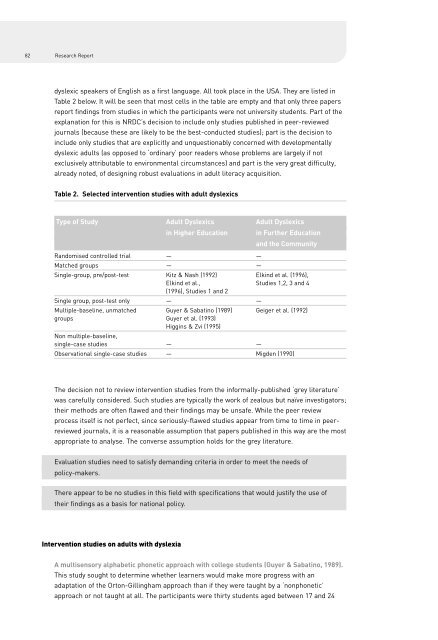01 NRDC Dyslexia 1-88 update - Texthelp
01 NRDC Dyslexia 1-88 update - Texthelp
01 NRDC Dyslexia 1-88 update - Texthelp
You also want an ePaper? Increase the reach of your titles
YUMPU automatically turns print PDFs into web optimized ePapers that Google loves.
82<br />
Research Report<br />
dyslexic speakers of English as a first language. All took place in the USA. They are listed in<br />
Table 2 below. It will be seen that most cells in the table are empty and that only three papers<br />
report findings from studies in which the participants were not university students. Part of the<br />
explanation for this is <strong>NRDC</strong>’s decision to include only studies published in peer-reviewed<br />
journals (because these are likely to be the best-conducted studies); part is the decision to<br />
include only studies that are explicitly and unquestionably concerned with developmentally<br />
dyslexic adults (as opposed to ‘ordinary’ poor readers whose problems are largely if not<br />
exclusively attributable to environmental circumstances) and part is the very great difficulty,<br />
already noted, of designing robust evaluations in adult literacy acquisition.<br />
Table 2. Selected intervention studies with adult dyslexics<br />
Type of Study Adult Dyslexics Adult Dyslexics<br />
in Higher Education in Further Education<br />
and the Community<br />
Randomised controlled trial — —<br />
Matched groups — —<br />
Single-group, pre/post-test Kitz & Nash (1992) Elkind et al. (1996),<br />
Elkind et al., Studies 1,2, 3 and 4<br />
(1996), Studies 1 and 2<br />
Single group, post-test only — —<br />
Multiple-baseline, unmatched Guyer & Sabatino (1989) Geiger et al. (1992)<br />
groups Guyer et al. (1993)<br />
Higgins & Zvi (1995)<br />
Non multiple-baseline,<br />
single-case studies — —<br />
Observational single-case studies — Migden (1990)<br />
The decision not to review intervention studies from the informally-published ‘grey literature’<br />
was carefully considered. Such studies are typically the work of zealous but naïve investigators;<br />
their methods are often flawed and their findings may be unsafe. While the peer review<br />
process itself is not perfect, since seriously-flawed studies appear from time to time in peerreviewed<br />
journals, it is a reasonable assumption that papers published in this way are the most<br />
appropriate to analyse. The converse assumption holds for the grey literature.<br />
Evaluation studies need to satisfy demanding criteria in order to meet the needs of<br />
policy-makers.<br />
There appear to be no studies in this field with specifications that would justify the use of<br />
their findings as a basis for national policy.<br />
Intervention studies on adults with dyslexia<br />
A multisensory alphabetic phonetic approach with college students (Guyer & Sabatino, 1989).<br />
This study sought to determine whether learners would make more progress with an<br />
adaptation of the Orton-Gillingham approach than if they were taught by a ‘nonphonetic’<br />
approach or not taught at all. The participants were thirty students aged between 17 and 24
















